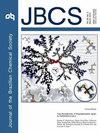废基聚苯乙烯泡沫载银纳米催化剂对硝基苯酚的热等离子体还原
IF 1.3
4区 化学
Q3 CHEMISTRY, MULTIDISCIPLINARY
引用次数: 0
摘要
向环境中排放塑料一直是环境的主要问题之一。聚苯乙烯(PS)的积累以一种加速的方式发生,因此,它的再利用是具有挑战性的。以聚苯乙烯残基为原料,制备了浸渍银纳米粒子的聚苯乙烯纳米复合材料(PS/AgNP),可用于催化和等离子体光催化还原对硝基苯酚(PNP)等酚类化合物为对氨基苯酚(PAP)。采用反胶束法合成AgNP,得到了尺寸为31.1 ~ 34.0 nm的纳米颗粒。用紫外可见光谱和动态光散射(DLS)对有机胶体进行了表征,证明制备了球形纳米颗粒。通过扫描电镜(SEM)、x射线衍射(XRD)、激光诱导击穿光谱(LIBS)和傅里叶变换可见红外光谱(FTIR)等手段证实了PS/AgNP的制备。纳米复合材料在蓝光照射下的催化和等离子体光催化还原中表现出令人印象深刻的性能,转化率高达98%,是废水处理和其他各种环境问题的有前途的材料。我们用蓝光观察了银纳米粒子的等离子体效应,在此之前还没有发现这种复合材料利用蓝光光催化还原PNP的报道。本文章由计算机程序翻译,如有差异,请以英文原文为准。
Silver Nanocatalyst Supported on Waste-Based Polystyrene Foam for Thermal and Plasmonic Reduction of p-Nitrophenol
Disposal of plastics into the environment has been one of the major problems for the environment. The accumulation of polystyrene (PS) occurs in an accelerated way and, therefore, its reuse is challenging. Polystyrene nanocomposites impregnated with Ag nanoparticles (PS/AgNP) are generated from polystyrene residues and can be applied in the catalytic and plasmonic photo-catalytic reduction of phenolic compounds such as p-nitrophenol (PNP) to p-aminophenol (PAP). The AgNP were synthesized by a reverse micelle method resulting in nanoparticles with sizes in a range of 31.1-34.0 nm. The organocolloid was characterized by UV-Vis and dynamic light scattering (DLS), demonstrating the preparation of spherical nanoparticles. The preparation of the PS/AgNP, obtained using a thermally induced phase separation method (TIPS), was confirmed by means of scanning electron microscopy (SEM), X-ray diffraction (XRD), laser-induced breakdown spectroscopy (LIBS), and Fourier transform visible infrared spectroscopy (FTIR). Nanocomposites showed impressive performance in the catalytic and plasmonic photocatalytic reduction under blue light irradiation, reaching up to 98% conversion, being a promising material for wastewater treatment as well as other various environmental issues. We used blue light to observe the plasmonic effect of silver nanoparticles, and no previous reports of this composite for PNP reduction using blue light photocatalysis were found.
求助全文
通过发布文献求助,成功后即可免费获取论文全文。
去求助
来源期刊
CiteScore
2.90
自引率
7.10%
发文量
99
审稿时长
3.4 months
期刊介绍:
The Journal of the Brazilian Chemical Society embraces all aspects of chemistry except education, philosophy and history of chemistry. It is a medium for reporting selected original and significant contributions to new chemical knowledge.

 求助内容:
求助内容: 应助结果提醒方式:
应助结果提醒方式:


